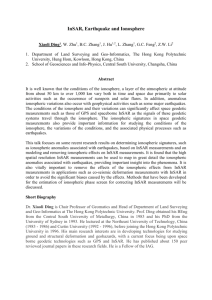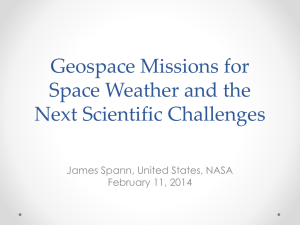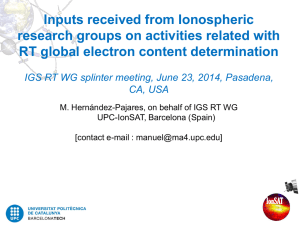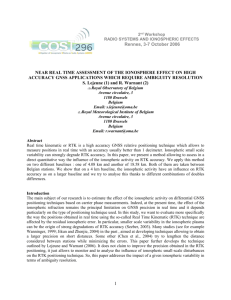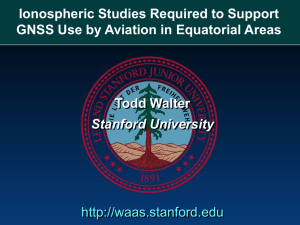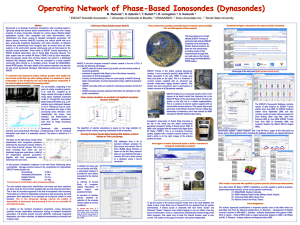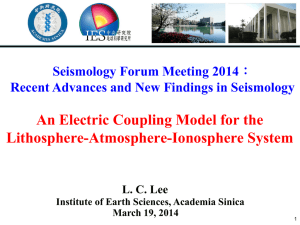3_4_Radicella
advertisement
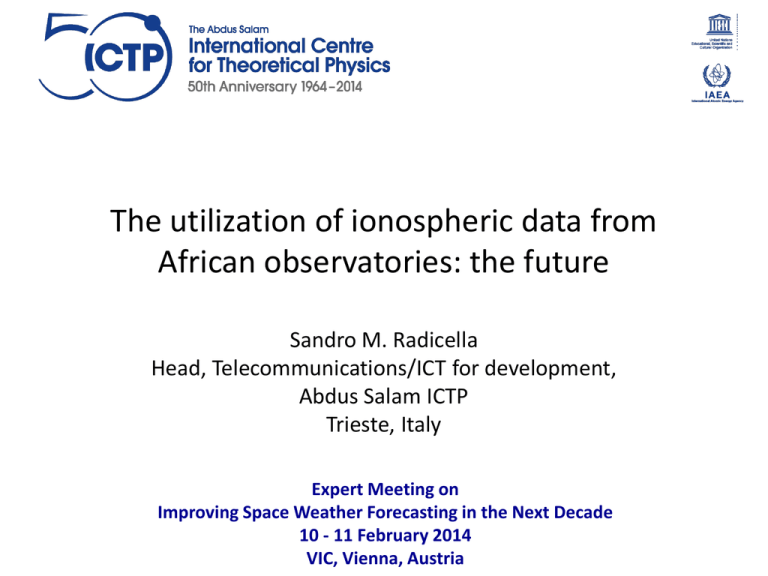
The utilization of ionospheric data from African observatories: the future Sandro M. Radicella Head, Telecommunications/ICT for development, Abdus Salam ICTP Trieste, Italy Expert Meeting on Improving Space Weather Forecasting in the Next Decade 10 - 11 February 2014 VIC, Vienna, Austria Ionospheric weather • Ionospheric weather is an important element of Space Weather. • Its forecast depends on data availability and knowledge of physical processes involved. • The ionosphere at the low latitudes affected by the so called “Ionospheric Equatorial Anomaly” (IEA) shows the highest variability and irregular behaviour indicating the existence of a very active and complex “weather” in that region of the globe. • Most of the African continent ionosphere is affected by the IEA. Ionospheric regions Ionospheric regions (a simplified view) Ionosphere over Africa (“climatic” NmF2) Ionospheric Research Issues for SBAS, SBAS Ionospheric Working Group, 2003 Arrows indicate the limits of continental Africa. Nava et al. 2001 Variability of TEC Variability of TEC at mid latitudes GPS derived vertical TEC at 5 min interval for Roquetes (Lat. 40.8º, Lon. 0.5º E, Mag. Dip 57º), October 2000. Variability of TEC at low latitudes GPS derived vertical TEC at 5 min interval for Libreville (Lat. 0.4º N, Long. 9.7º E, Mag. Dip –25º), October 2000. However How competing influences from above and below control ionospheric weather, particularly over Africa? http://icon.ssl.berkeley.edu/science/ Ionosphere-troposphere coupling (1) • Most of the ionospheric variability is attributed to geomagnetic activity. • But, scientific literature since the early 80’ of last century indicates that coupling with tropospheric processes can play an important role in such variability. • Potential effects of convective complexes and intense tropospheric storms have been indicated as possible origin of waves and tides in the F-region of the ionosphere that influences its variability (Emanuel and Sanders, 1983; Manzano et al, 1998; Martinis and Manzano, 1999; P. Sauli and J. Boska, 2001, Bishop et al, 2006) • The last 8 years have shown an increased interest about this topic including the possible effects of non-migrating tides of tropospheric origin as an explanation of the longitudinal variations of the IEA development, and the effects of the ENSO on the low latitude ionosphere. (Immel et al, 2006; Pedatella and Forbes, 2009) Ionosphere-troposphere coupling (2) • In particular 2011-2013 published papers have shown lower atmosphereionosphere model results that indicate that at low latitudes a substantial percentage of the electron density variability can be of tropospheric origin including the effect of ENSO. (Jin et al, 2011, Pedatella and Liu, 2013, Liu et al, 2013) • The effect of non-migrating tides has been shown also in TEC behaviour over South America using model calculations (Nogueira et al, 2013) Ionosphere-troposphere coupling (3) Liu et al, 2013, indicate that The dayto-day ionosphere variability in the model is primarily caused by the perturbations originated in lower atmosphere, since the model simulation is under constant solar minimum and low geomagnetic conditions. Ionosphere-troposphere coupling (4) Pedatella and Liu, 2013, show that the ENSO introduces inter-annual variability of 10–15% in the ionosphere. The ENSO should therefore be considered as a potentially significant source of variability in the Earth’s upper atmosphere. The state of the art at present • It appears evident now that ionospheric weather at low latitudes cannot be attributed only to solar and geomagnetic activity but is also linked to the troposphere. • Model simulation results are giving solid clues about the way tropospheric activity affects ionospheric weather. • However, more experimental evidences are required to be able to reach an adequate forecasting capacity particularly in regions like the African continent. • The quantitative estimates of both solar-geomagnetic activity and forcing from below are needed to allow a sound forecast of ionospheric weather. The present situation in Africa (1) • A recent Competence Survey under the ESA ALCANTARA Initiative “Ionospheric ground based monitoring network in low-latitude regions: Africa” done by ICTP with the collaboration of Profs. B. Rabiu (NASDA, Nigeria) and O. Obrou (University of Cocody, Cote d’Ivoire) have allowed to see the present status of ionospheric observations and research in Africa in general and at low latitudes in particular. From the survey it appears evident that now-days the number of GNSS receivers able to provide ionospheric information allows to start systematic research of the type needed for ionospheric weather assessment. The present situation in Africa (2) • Ionosondes able to provide direct information about the height profile of the electron density are needed to complete such research. At the moment only three ionosondes are operating or will operate in the near future in the African equatorial region. • Magnetometers from several projects are installed in key locations in low latitudes and can contribute efficiently to the research on ionospheric weather. • The use of satellite in-situ ionospheric information together with ground based observations would contribute substantially to assess ionospheric weather. The present situation in Africa (3) • If the investigation is combined with adequate tropospheric activity studies, a sound forecast of ionospheric weather could be achieved. • A key point is that research on ionospheric weather at low latitudes in African has to be made with the substantial contribution from African scientists to guarantee a sustainable effort for several years to come. • The present situation of ionospheric research done in Africa indicates that this is possible. Ionospheric research in Africa • The ALCANTARA Survey provided very interesting results about ionospheric research by African scientists working in the continent. • Data about the growing number of papers published in peer-review journals by these scientists are encouraging. Examples of recent ionospheric research in Africa (1) Inospheric variability (ionospheric weather): Solar Eclipse effect over Ilorin, Nigeria Adeniyi et al, 2009 Examples of recent ionospheric research in Africa (2) Inospheric variability (ionospheric weather): TEC variability over Ilorin, Nigeria Bolaji et al 2012 The contribution from the international community (1) • It has to be noted that most of the instruments operating in the African low latitudes have been provided by national or international institutions, projects or program like AMBER, MAGDAS, SHINDA, Boston College, Stanford University, Kyoto University and ICTP. • Training of African scientists have benefited by the efforts of African Universities like Rhodes University of South Africa, Ilorin University in Nigeria, Bahir Dar University in Ethiopia, University of Cocody in Cote d’Ivoire. The contribution from the international community (2) • An important contribution to the training of African scientists was done by the "Groupe International de Recherche en Géophysique Europe Afrique" (GIRGEA) organized by Dr. Christine Amory-Mazaudier of the Laboratory of Plasma Physics of the French CNRS. • Another contribution in the same direction came through the Partnership between Boston College and ICTP towards the establishment of African research groups in the area of GNSS science and technology with a strong emphasis on ionospheric research using GNSS receivers. In summary (1) • I concentrated my attention to the problem of assessing the relative contribution of solar-geomagnetic and tropospheric effects on ionospheric weather at low latitudes to obtain its forecasting. • This subject should become an important topic for future studies towards Space Weather Forecasting in general and Ionospheric Weather Forecasting in particular. • African data, particularly from the low latitudes region of the continent, are essential for such work. In summary (2) • At present exists a basic network of observatories in Africa able to get ionospheric information or related type of data. • There is an increasing number of scientists doing ionospheric research in the continent. • African scientists should be able to participate in these studies in collaboration with researchers from other regions of the world. • It has to be remember that Ionospheric Weather forecasting is of key importance not only for its intrinsic scientific value but also for telecommunications and satellite navigation applications. References (1) • • • • • • J. O. Adeniyi, O. A. Oladipo, S. M. Radicella,. A. Adimula, and A. O. Olawepo; Journal of Geophysical Research, VoL. 114, A11303, doi:10.1029/2009JA014416, (2009) O. S. Bolaji, J. O. Adeniyi, S. M. Radicella, and P. H. Doherty; Radio Science, Vol. 47, RS1001, doi:10.1029/2011RS004812, (2012) R. L. Bishop, N. Aponte, G. D. Earle, M. Sulzer, M. F. Larsen, and G. S. Peng, Journal of Geophysical Research, Vol. 111, A11320, doi:10.1029/2006JA011668, (2006) K. Emanuel and F. Sanders, Reviews of Geophysics and Space Physics, Vol. 21, No. 5, 1027-1042, (1983) T. J. Immel, E. Sagawa, S. L. England, S. B. Henderson, M. E. Hagan, S. B. Mende, H. U. Frey, C. M. Swenson, and L. J. Paxton, Geophysical Research Letters, Vol. 33, L15108, doi:10.1029/2006GL026161, (2006) B. Nava, Radicella S.M., Pulinets S. and Depuev V. “Modelling bottom and topside electron density and TEC with profile data from topside ionograms”, Advances in Space Research, V. 27, pp. 31-34, (2001). References (2) • • • • • • • • P. A. B. Nogueira, M. A. Abdu, J. R. Souza, G. J. Bailey, I. S. Batista, E. B. Shume, and C.M. Denardini; Journal of Geophysical Research: Space Physics, Vol. 118, 7940–7953, doi:10.1002/2013JA019266, (2013) J. R. Manzano”, S. M. Radicella, M. M. Zossi de Artigasa, A. N. Filippi de Manzanoa, A. H. Cosio de Ragone, Journal of Atmospheric and Solar-Terrestrial Physics 60, 585-594, (1998) C. R. Martinis and J. R. Manzano, Annali di Geofisica, Vol 42, No 1, (1999) H. Jin, Y. Miyoshi, H. Fujiwara, H. Shinagawa, K. Terada, N. Terada, M. Ishii, Y. Otsuka, and A. Saito; Journal of Geophysical Research, Vol. 116, A01316, doi:10.1029/2010JA015925, (2011) H.-L. Liu, V. A. Yudin, and R. G. Roble; Geophysical Research Letters, Vol. 40, 665–670, doi:10.1002/GRL.50125, (2013) N. M. Pedatella and J. M. Forbes, Journal of Geophysical Research, Vol. 114, A12316, doi:10.1029/2009JA014494, (2009) N. M. Pedatella and H.-L. Liu; Journal of Geophysical Research: Space Physics, Vol. 118, 2744–2755, doi:10.1002/jgra.50286, (2013) P. Sauli and J. Boska, Journal of Atmospheric and Solar-Terrestrial Physics 63, 945–950, (2001) :10.1029/2006GL026161, (2006) THANK YOU FOR YOUR ATTENTION
